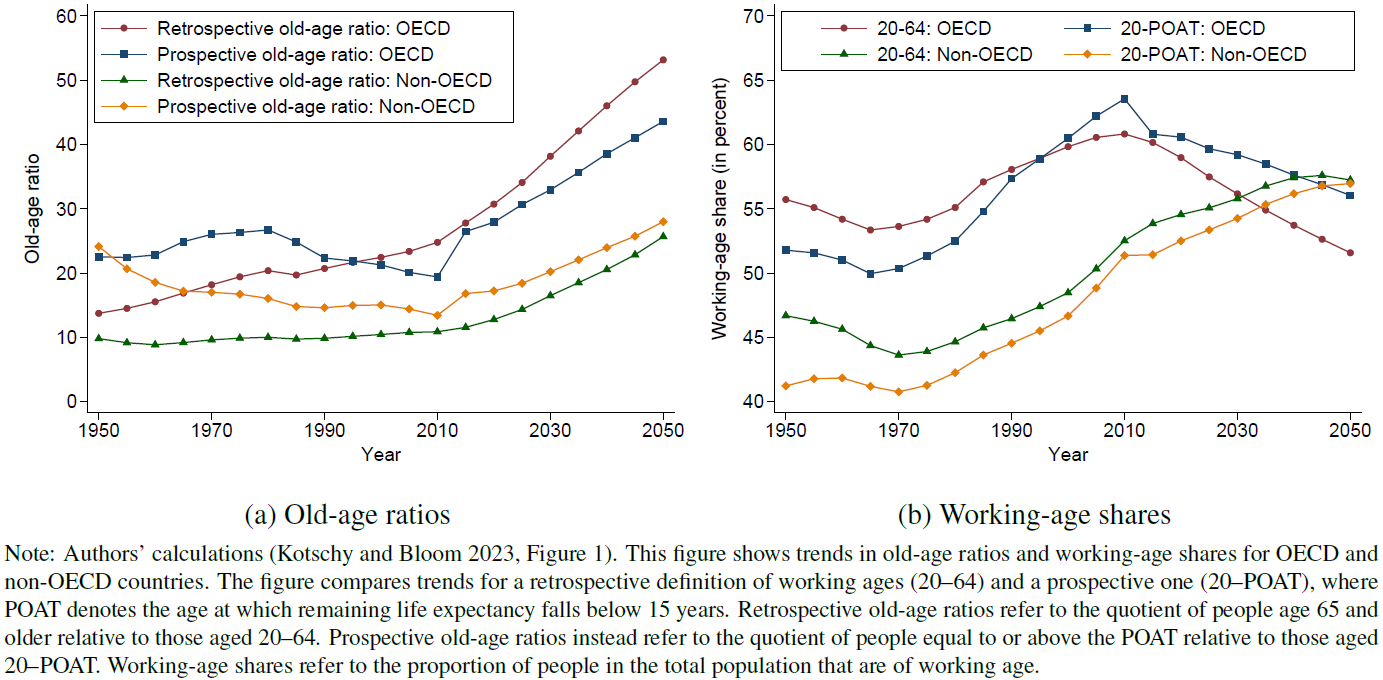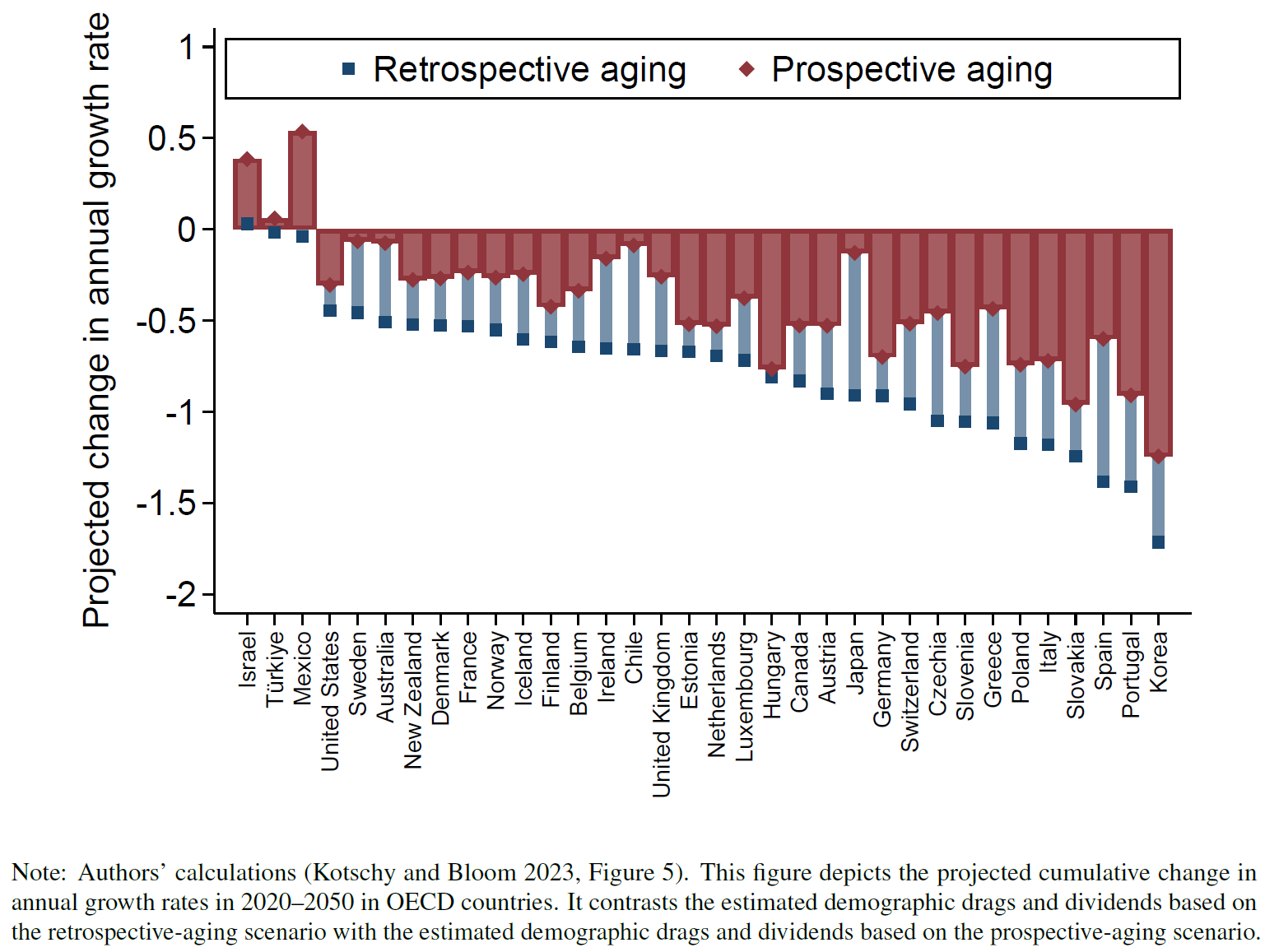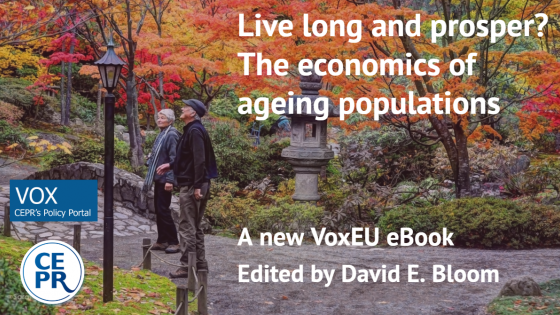Population ageing is the most pervasive and dominant demographic trend of the 21st century. The economic consequences of this trend are the focus of an increasing body of research. Based on an analysis of 22 OECD countries in 1970–2014, Aksoy et al. (2019) attribute to population ageing a significant slowdown in the projected growth rate of income per capita (0.64 percentage points per annum) during 2011–2030. Maestas et al. (2023) analyse panel data for US states in 1980–2010 and predict a similar slowdown during 2020–2030 (0.60 percentage points per annum). These studies and many others proxy population ageing by the population share aged 60 (or 65) and over.
In a new study (Kotschy and Bloom 2023), we explore the effects of population ageing on economic growth for a global sample of 145 (OECD and non-OECD) countries. We analyse these effects with data for a wide time frame (1950–2015) and construct projections far into the future (2020–2050) to capture a broad picture of the economic consequences of population ageing. An important innovation of our study compared to previous work is the distinction among different conceptualisations of population age structure. We investigate how the economic effects of population ageing change if one adopts a functional measure instead of a chronological measure of population age structure. The chronological measure focuses on the share of the population aged 20–64, whereas the functional measure focuses on the share of the population aged 20–POAT, where POAT (prospective old-age threshold) is the age at which remaining life expectancy falls below 15 years. Although we find that population ageing conveys a contractionary impulse to macroeconomic performance, our estimates reveal that perhaps half the projected slowdown in a model based on chronological age can be offset by improvements in functional capacity associated with rising longevity.
The devil is in the details
Driven by declining fertility, increasing longevity, and large cohorts advancing to older ages, population ageing has replaced population growth as the foremost global demographic trend (Bloom 2022). This shift has introduced a multitude of interconnected challenges – health, social, and economic – which portends significant changes to economic growth, the composition of the workforce, and the financial viability of pension and health care systems. Plausible responses to this trend include the implementation of policies that promote healthy ageing, such as healthcare innovations, retirement programme reforms, and the development of comprehensive and sustainable long-term care systems (Bloom 2022, Kotschy and Bloom 2022).
Designing and targeting those policies can be extremely complex, however, as ageing, health, technology, and employment intersect in complicated ways. For example, which job an individual has influences when they retire, potentially more so than worker characteristics. Sauré et al. (2023) document that retirement behavior across 45 countries is determined by the occupational composition of the workforce. Technological innovation can in turn change the occupational composition of the workforce, which can absorb pressure from social security systems when combined with incentives to postpone retirement. However, Spinnewijn et al. (2022) show that incentivising later retirement in the pursuit of the fiscal sustainability of pension systems often carries substantial redistributive costs – though less so in the age range 60–65 where such incentives provide an opportunity to smooth consumption across different types of households. Bellés-Obrero et al. (2022), meanwhile, find that mortality can increase with delayed retirement – especially for those aged 60–69 in physically and psychosocially demanding jobs – but also that flexible retirement policies can mitigate this effect.
An oft-raised concern regarding the postponement of retirement relates to the possibility that continued employment of older workers might crowd young workers out of the labour market. Yet, a review of a 2012 Italian pension reform (Amuri 2021) indicates that an increase in the retirement age does not mean fewer younger workers. This study reveals an increase in employment across all age classes, including the young, and even documents an increase in value added. Instead of older workers being burdens, this study suggests they possess unique – and complementary – skills that are not easily replaced.
The creation of more age-friendly jobs addresses many challenges posed by population ageing; however, it is not a panacea. Scott et al. (2022) note that while the US job market has become more age-friendly over the years, those jobs have primarily been filled by younger women and college graduates, leaving a significant portion of older workers behind. Another relevant trend is the evolving relationship of fertility and employment. The increasing compatibility of women’s career goals and family plans explains the economics of modern fertility, where fertility rates are higher in countries with higher female employment. Tertilt et al. (2022) demonstrate how a combination of factors, including advantageous governmental family policies and flexible labour markets, are driving this trend, which aligns with other recent literature that rejects the notion of demography as destiny (Bloom 2019).
Demography is not destiny
Indeed, the only thing predetermined about demography is change. Bloom et al. (2003) coined the term ‘demographic dividend’ to describe the economic development that can result from a society’s change in age structure and population growth. As mortality and fertility rates drop, living standards can rise and the cohort of former dependents progresses to working age, increasing labour supply and diverting resources to savings, education, and productivity advancements. Yet once the transition is complete, that same cohort moves into older ages and threatens to impede said economic growth. In short, the demographic dividend has the potential to morph into a demographic drag.
While the drag seems somewhat inevitable – practically every OECD country is experiencing population ageing and an attendant shrinking workforce, leading to predictions of economic slowdowns across the board – its size and scope are not. The logic of the inevitability is straightforward: as the cohorts from baby booms cycle past working age, the quantity of workers declines and resources used to fuel productivity are then used for old-age consumption. But predicting exactly how this scenario will impact economic growth is difficult, as the variables are quite nebulous. How will society counteract these effects with investments in education, technological progress, and initiatives to promote healthy ageing that could result in increased functional capacity (that may lead more older individuals to remain in the labour market or to contribute via valuable non-market activities)? How will increased automation, capital deepening, and the uncertainty of data extrapolations inherent to these estimates complicate economic projections?
In Kotschy and Bloom (2023), we pose these questions and seek to estimate how population ageing will impact economic growth and how those effects might be attenuated by improvements in age-specific functional capacities.
The conventional measure of working age used to answer such questions classifies old age the same for every generation. This retrospective approach focuses entirely on chronological age and therefore ignores advancements in functional capacity in terms of mortality, disability, strength, and cognition wrought by healthy ageing. However, a 65-year-old in 1973 can differ substantially from a 65-year-old in 2023. For example, life expectancy at age 65 in the US rose from 15 to 19 years between 1970 and 2020 and is projected to reach 23 years by 2050 (United Nations 2022). Therefore, categorising those aged 65 as old – which, in effect, means ‘too old to work’ – is significantly undercounting the labour potential, an oversight that will only be exacerbated in the future.
Therefore, in contrast to the retrospective approach that relies on years lived since birth, we also use a prospective approach developed by Sanderson and Scherbov (2005, 2007, 2010, 2019) that measures working ages based on expected years of life ahead. This approach employs a variable prospective old-age threshold (POAT) defined as the age at which remaining life expectancy falls below 15 years (Sanderson et al. 2017). This threshold increases with longevity and significantly correlates with various measures of functional capacity, including mortality, physiological ageing, body strength, and cognitive capacity (Table 1 in Kotschy and Bloom 2023).
Retrospective and prospective approaches to the measurement of population age structure can produce qualitatively and quantitatively different demographic trends (see Figure 1). Beginning in 2000, for example, OECD countries appear younger when we consider prospective rather than retrospective measures of population age structure, whereas non-OECD countries appear older. By focusing solely on chronological age, the retrospective approach thus misses important variation in functional capacity that the prospective approach captures.
Figure 1 Differences between retrospective and prospective measures of population age structure
In contrasting the retrospective and prospective approaches, we present a range of possible economic consequences of population ageing. Notably, the two approaches only differ with respect to population age structure. We use these differences as alternative scenarios in projections of future income per capita growth and compare them with a counterfactual in which population age structure is constant. This comparison allows us to gauge the likely effects of population ageing on economic growth: “[b]y characterising labor potential under fixed and evolving functional capacities, retrospective and prospective measures indicate bounds for how shrinking working-age shares might affect economic growth in the years ahead” (Kotschy and Bloom 2023: 1).
We begin our investigation by developing an empirical growth model, which considers country variations in working-age shares, human capital, physical capital, population health, and growth trends, fitted to panel data for 145 countries in five-year intervals throughout 1950–2015. We then use the estimated parameters of this model, along with demographic forecasts, to estimate the implications of population ageing for projected growth of income per capita in 2020–2050. While a slowdown in income per capita growth occurs in both scenarios, the prospective approach indicates that the economic consequences of population ageing will be less dire than estimates based on cohort structure alone suggest. Across OECD countries, our results suggest that “expanding economic activity through improvements in functional capacity can cushion perhaps one-half of [the] demographic drag” (Kotschy and Bloom 2023: 19). The differing approaches also display considerable cross-country variance (Figure 2): the annual growth rates of income per capita are estimated to drop by 0.91 percentage points in Japan, 0.66 percentage points in Chile, and 0.46 percentage points in Sweden under retrospective ageing, whereas they are 0.13 percentage points in Japan, 0.09 percentage points in Chile, and 0.06 percentage points in Sweden under prospective ageing. The potential to offset the demographic drag increases with remaining life expectancy as people can extend labour market activity further into later stages of the life cycle. For the US, our results show an economic slowdown of 0.45 percentage points in 2020–2050 for retrospective ageing but only a reduction of 0.30 percentage points for prospective ageing. Economic growth is estimated to slow the most in the Republic of Korea (the fastest ageing country in the world) with a drop in annual income per capita rates of 1.71 percentage points under retrospective ageing and a drop of 1.24 percentage points under prospective ageing. As people around the world continue to live longer and healthier lives, incorporating the upper and lower bounds borne of these varied approaches will only gain in importance for the conduct of meaningful economic analyses.
Figure 2 Projected cumulative change in annual growth rates in 2020–2050 in OECD countries under retrospective and prospective ageing
The demographic headwinds can be harnessed
Older cohorts ageing out of the labour market will undoubtedly impede economic growth, though likely not by the magnitude predicted based on a retrospective measure of ageing. Migration, technological innovation, the automation of physically rigorous jobs, and the creation of more age-friendly employment opportunities can mitigate this slowdown to some extent. A promising prospect for countering this trend involves interventions that augment functional capacity at older ages. While said gains provide the means for individuals to remain in the labour market for longer, that outcome is not guaranteed. This opportunity must be fortified by institutions and policies that enable or incentivise old-age employment (or making valuable nonmarket contributions), safe workplaces, adequate social safety nets of pension systems and healthcare provisions, and the reduction of health, social, and economic inequalities (Berkman et al. 2022).
Uncertainties about the rate of technological progress, climate change, the emergence of pandemics, and the destabilizing effect of war complicate the assessment of how population ageing will interact with economic growth. Therefore, this is an ongoing endeavour that should receive continual data updates to reflect evolving real-world conditions. Other areas of future research include how different measures of prospective ageing from the one presented here reflect functional capacity and its impact on economic growth; how extended stays in the workforce can offset the strains on pension systems; and the distributional and welfare repercussions of policies designed to expand the economic activities of older people.
References
Aksoy, Y, H S Basso, R P Smith, and T Grasl (2019), “Demographic Structure and Macroeconomic Trends,” American Economic Journal: Macroeconomics 11: 193–222.
Amuri, F D, T von Wachter, and F Carta (2021), “Workforce ageing, pension reforms, and firms’ outcomes,” VoxEU.org, 16 march.
Bellés-Obrero, C, S Jiménez-Martín, and H Ye (2022), “The effect of removing early retirement on mortality,” VoxEU.org, 1 December.
Berkman, L F, BC Truesdale, and A Mitukiewicz (2022), “What Is the Way Forward? American Policy and Working Longer,” in L F Berkman and B C Truesdale (eds), Overtime: America’s Aging Workforce and the Future of Working Longer, Oxford University Press, pp. 301–321.
Bloom, D E, D Canning, and J P Sevilla (2003), The Demographic Dividend: A New Perspective on the Economic Consequences of Population Change, RAND MR-1274.
Bloom, D E (2019), “Sailing into uncharted demographic waters,” VoxEU.org, 14 October.
Bloom, D E (2022), “Healthy aging for a healthy economy,” VoxEU.org, 15 November.
Kotschy, R and D E Bloom (2022), “A comparative perspective on long-term care systems,” International Social Security Review 75: 47–69.
Kotschy, R and D E Bloom (2023), “Population Aging and Economic Growth: From Demographic Dividend to Demographic Drag?”, CEPR Discussion Paper No. 18400.
Maestas, N, K J Mullen, and D Powell (2023), “The Effect of Population Aging on Economic Growth, the Labor Force and Productivity,” American Economic Journal: Macroeconomics 15: 306–332.
Sanderson, W C and S Scherbov (2005), “Average Remaining Lifetimes Can Increase as Human Populations Age,” Nature 435: 811–813.
Sanderson, W C and S Scherbov (2007), “A New Perspective on Population Aging,” Demographic Research 16: 27–58.
Sanderson, W C and S Scherbov (2010), “Remeasuring Aging,” Science 329: 1287–1288.
Sanderson, W C and S Scherbov (2019), Prospective Longevity: A New Vision of Population Aging, Harvard University Press.
Sanderson, W C, S Scherbov, and P Gerland (2017), “Probabilistic Population Aging,” PloS ONE 12, 0179171.
Sauré, P, A Seibold, E Smorodenkova, and H Zoabi (2023), “Occupations shape retirement across countries,” VoxEU.org, 30 June.
Scott, A, N Søndergaard Mühlbach, and D Acemoglu (2022), “The increasing age-friendliness of US employment,” VoxEU.org, 27 October.
Spinnewijn, J, C Landais, D Reck, and J Kolsrud (2022), “The hidden costs of incentivising later retirement,” VoxEU.org, 22 March.
Tertilt M, A Hannusch, F Kindermann, and M Doepke (2022), “A new era in the economics of fertility,” VoxEU.org, 11 June.
United Nations (2022), World Population Prospects: The 2022 Revision, UN Department of Economic and Social Affairs, Population Division.





